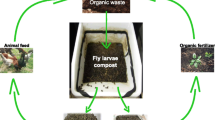Abstract
There is currently no market in Israel for the large amounts of waste from fish- and poultry-processing plants. Therefore, this waste is incinerated, as part of the measures to prevent the spread of pathogens. Anaerobic methanogenic thermophilic fermentation (AMTF) of wastes from the cattle-slaughtering industry was examined previously, as an effective system to treat pathogenic bacteria, and in this article, we discuss a combined method of digestion by thermophilic anaerobic bacteria and by flesh flies, as a means of waste treatment. The AMTF process was applied to the wastes on a laboratory scale, and digestion by rearing of flesh fly (Phaenicia sericata) and housefly (Musca domestica) larvae on the untreated raw material was done on a small scale and showed remarkable weight conversion to larvae. The yield from degradation of poultry waste by flesh fly was 22.47% (SD=3.89) and that from fish waste degradation was 35.34% (SD=12.42), which is significantly higher than that from rearing houseflies on a regular rearing medium. Bacterial contents before and after thermophilic anaerobic digestion, as well as the changes in the chemical composition of the components during the rearing of larvae, were also examined.
Similar content being viewed by others
References
Klinger, I. and Marchaim, U. (1987). Isr. J. Vet. Med. 43, 181–187.
Zenkevitch, L. A. (1969), Prosveshenie (Moscow) 3, 516–518 (in Russian).
Prete, P. E. (1997), Life Sci. 60, 505–510.
Casu, R., Eisemann, C., Vuocola, T., and Tellam, R. (1996), Int. Parasitol. 6, 623–628.
Wijffels, G., Gough, J., Muharsini, S., Donaldson, A., and Eisemann, C. (1997), Insect. Biochem. Mol. Biol. 5, 451–460.
Cunniff, P., ed. (1995), Official Methods of Analysis, 16th ed., Association of Official Analytical Chemists (AOAC), Gaithersburg, MD.
Vanderzant, C. and Splittstoesser, D. F. (1992), Compendium of Methods for the Microbial Examination of Food, American Public Health Association, Washington, DC.
Marchaim, U., Kostenberg, D., and Epstein, E. (1997), Mikrobiologiya 66, 706–711.
Salminen, E., Rintala, J., Lokshina, L. Y., and Vavilin, V. A. (2000), Water Sci. Technol. 41, 33–41.
Author information
Authors and Affiliations
Corresponding author
Rights and permissions
About this article
Cite this article
Marchaim, U., Gelman, A. & Braverman, Y. Reducing waste contamination from animal-processing plants by anaerobic thermophilic fermentation and by flesh fly digestion. Appl Biochem Biotechnol 109, 107–115 (2003). https://doi.org/10.1385/ABAB:109:1-3:107
Issue Date:
DOI: https://doi.org/10.1385/ABAB:109:1-3:107




